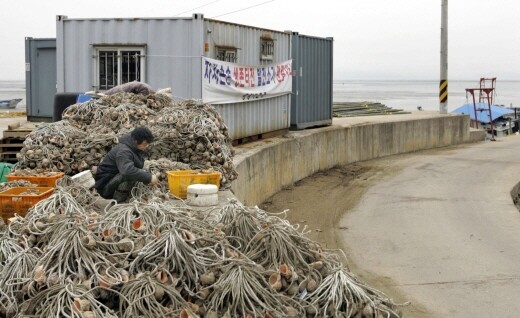hankyoreh
Links to other country sites 다른 나라 사이트 링크
Renewable energy faces investment crisis in S.Korea

Investment in solar power generation equipment has declined precipitously. The net capacity declined from 275.7 megawatts (MW) in 2008 to 72.5 MW last year. This is due to cuts in subsidies to pay the difference in power generation costs. The Ministry of Knowledge Economy enacted measures in April to reduce the subsidies for renewable energy sources such as solar energy, limiting the subsidy coverage to 50 MW in 2009, 70 MW in 2010 and 80 MW in 2011.
South Korea’s solar power generation capacity, just 1 MW in 2005, stood at 429 MW as of February 2010. This is the result of small and medium-sized firms actively entering into the industry, believing there to be stable demand thanks to the government support through subsidies. As of January of this year, 413 companies were members of the Korea Power Exchange, a 37.2 percent increase from the year before. The number of small energy companies in the renewable energy field, including solar (302), small-scale hydropower (17) and wind power (12), has increased greatly. However, Photovoltaic Energy Producers Association Vice Chairman Jeong Dong-il said because of the subsidy cuts, small-scale producers who have led the way in the domestic solar power industry, equipment firms and builders have taken a major hit.
The Lee Myung-bak administration’s understanding of the situation is quite a stark contrast to these developments. They believe that while it is true that the market has increased due to the subsidies, there have been a great number of side effects, including the skyrocketing importation of foreign-made materials and parts. Hwang Soo-sung, director of the Ministry of Knowledge Economy’s renewable energy division, said that since South Korea’s domestic renewable energy industry lacks the proper conditions, a cut in the subsidies is unavoidable. He said the ministry still plans to increase the market for small and medium-sized producers, such as fixing mandatory energy sales to large energy companies or granting points to small-scale and household production, even if it must adopt a mandatory quota.
The main problem is effectiveness. One businessman who has run a solar power station and is considering expanding his plant, said producers now have to decide whether or not to conduct the business either by clearing the hurdle of the slashed subsidies or examining the necessarily uneven orders of power companies. He said it is hard for small and medium-sized firms to invest based on these thin chances. An official of one manufacturing firm that specializes in electrical power equipment said that major power companies with investment wherewithal can accept the risk, but most small and medium-sized firms find it difficult even to raise the capital from banks.
The decrease in investment in solar power generation plants is having an effect on the entire industry. Lee Seong-ho, vice chairman of the Korea Photovoltaic Industry Association, said that if solar power generation in South Korea decreases due to the termination of subsidies, it could hurt related industries such as the production of photovoltaic modules. Some suggest as a solution simultaneous quotas and subsidies.
Please direct questions or comments to [englishhani@hani.co.kr]
Editorial・opinion
![[Column] Season 2 of special prosecutor probe may be coming to Korea soon [Column] Season 2 of special prosecutor probe may be coming to Korea soon](https://flexible.img.hani.co.kr/flexible/normal/500/300/imgdb/original/2024/0426/3317141030699447.jpg) [Column] Season 2 of special prosecutor probe may be coming to Korea soon
[Column] Season 2 of special prosecutor probe may be coming to Korea soon![[Column] Park Geun-hye déjà vu in Yoon Suk-yeol [Column] Park Geun-hye déjà vu in Yoon Suk-yeol](https://flexible.img.hani.co.kr/flexible/normal/500/300/imgdb/original/2024/0424/651713945113788.jpg) [Column] Park Geun-hye déjà vu in Yoon Suk-yeol
[Column] Park Geun-hye déjà vu in Yoon Suk-yeol- [Editorial] New weight of N. Korea’s nuclear threats makes dialogue all the more urgent
- [Guest essay] The real reason Korea’s new right wants to dub Rhee a founding father
- [Column] ‘Choson’: Is it time we start referring to N. Korea in its own terms?
- [Editorial] Japan’s rewriting of history with Korea has gone too far
- [Column] The president’s questionable capacity for dialogue
- [Column] Are chaebol firms just pizza pies for families to divvy up as they please?
- [Column] Has Korea, too, crossed the Rubicon on China?
- [Correspondent’s column] In Japan’s alliance with US, echoes of its past alliances with UK
Most viewed articles
- 1[Column] Season 2 of special prosecutor probe may be coming to Korea soon
- 2No good, very bad game for Korea puts it out of Olympics for first time since 1988
- 3‘We must say no’: Seoul defense chief on Korean, USFK involvement in hypothetical Taiwan crisis
- 4Korea’s 1.3% growth in Q1 signals ‘textbook’ return to growth, says government
- 5Division commander ordered troops to enter raging flood waters before Marine died, survivor says
- 6Is N. Korea threatening to test nukes in response to possible new US-led sanctions body?
- 7Is Japan about to snatch control of Line messenger from Korea’s Naver?
- 8[Editorial] In the year since the Sewol, our national community has drowned
- 9[Editorial] 10 years on, lessons of Sewol tragedy must never be forgotten
- 10[Editorial] New weight of N. Korea’s nuclear threats makes dialogue all the more urgent